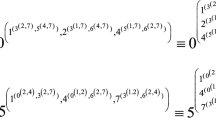Abstract
In this paper we consider three variants of accepting networks of evolutionary processors. It is known that two of them are equivalent to Turing machines. We propose here a direct simulation of one device by the other. Each computational step in one model is simulated in a constant number of computational steps in the other one while a translation via Turing machines squares the time complexity. We also discuss the possibility of constructing simulations that preserve not only complexity, but also the shape of the simulated network.



Similar content being viewed by others
References
Alhazov A, Bel Enguix G, Rogozhin Y (2009a) Obligatory hybridnetworks of evolutionary processors. In: International conference on agents and artificial intelligence (ICAART 2009), pp 613–618
Alhazov A, Csuhaj-Varj E, Martn-Vide C, Rogozhin Y (2009b) On the size of computationally complete hybrid networks ofevolutionaryprocessors. Theor Comput Sci 410:3188–3197
Bottoni P, Labella A, Manea F, Mitrana V, Sempere J (2009a) Filter position in networks of evolutionary processors does not matter: a direct proof. In: Proc. 15th international meeting on DNA computing and molecular programming. 8–11 June 2009, Fayetteville, Arkansas
Bottoni P, Labella A, Mitrana V, Sempere JM (2009b) Networks of evolutionary picture processors with filtered connections. In: Unconventional computation, 8th international conference (UC 2009), LNCS, vol 5715. Springer, Heidelberg, pp 70–84
Castellanos J, Martín-Vide C, Mitrana V, Sempere J (2001) Solving NP-complete problems with networks of evolutionary processors. In: International work-conference on artificial and natural neural networks (IWANN 2001), Lecture notes in computer science, vol 2084, pp 621–628
Csuhaj-Varjú E, Mitrana V (2000) Evolutionary systems: a language generating device inspired by evolving communities of cells. Acta Inform 36:913–926
Csuhaj-Varjú E, Salomaa A (1997) Networks of parallel language processors. In: New trends in formal languages, Lecture notes in computer science, vol 1218, pp 299–318
Dassow J, Truthe B (2007) On the power of networks of evolutionary processors. In: Machines, computations, and universality (MCU 2007), Lecture notes in computer science, vol 4667, pp 158–169
Drăgoi C, Manea F (2008) On the descriptional complexity of accepting networks of evolutionary processors with filtered connections. Int J Found Comput Sci 19:1113–1132
Drăgoi C, Manea F, Mitrana V (2007) Accepting networks of evolutionary processors with filtered connections. J Univers Comput Sci 13:1598–1614
Errico L, Jesshope C (1994) Towards a new architecture for symbolic processing. In: Artificial intelligence and information-control systems of robots ’94, World Scientific, Singapore, pp 31–40
Fahlman SE, Hinton GE, Seijnowski TJ (1983) Massively parallel architectures for AI: NETL, THISTLE and Boltzmann machines. In: Proc. of the national conference on artificial intelligence, pp 109–113
Hillis W (1985) The connection machine. MIT Press, Cambridge
Manea F, Martin-Vide C, Mitrana V (2007) On the size complexity of universal accepting hybrid networks of evolutionary processors. Math Struct Comput Sci 17:753–771
Margenstern M, Mitrana V, Perez-Jimenez M (2005) Accepting hybrid networks of evolutionary systems. In: DNA based computers 10, Lecture notes in computer science, vol, pp 235–246
Martín-Vide C, Mitrana V (2005) Networks of evolutionary processors: results and perspectives. In: Molecular computational models: unconventional approaches. dea Group Publishing, Hershey, pp 78–114
Păun G (2000) Computing with membranes. J Comput Syst Sci 61:108–143
Păun G, Sântean L (1989) Parallel communicating grammar systems: the regular case. Ann Univ Bucharest Ser Matematica Inform 38:55–63
Rozenberg G, Salomaa A (eds) (1997) Handbook of formal languages. Springer–Verlag, Berlin
Sankoff D et al. (1992) Gene order comparisons for phylogenetic inference: evolution of the mitochondrial genome. Proc Natl Acad Sci USA 89:6575–6579
Acknowledgements
This work was supported by the Academy of Finland, projects 132727, 122426, and 108421. F. Manea acknowledges the support from the Alexander von Humboldt Foundation. J Sempere acknowledges the support from the Spanish Ministerio de Educación y Ciencia project TIN2007-60769.
Author information
Authors and Affiliations
Corresponding author
Additional information
Florin Manea is on leave of absence from the University of Bucharest.
Rights and permissions
About this article
Cite this article
Bottoni, P., Labella, A., Manea, F. et al. Complexity-preserving simulations among three variants of accepting networks of evolutionary processors. Nat Comput 10, 429–445 (2011). https://doi.org/10.1007/s11047-010-9238-5
Published:
Issue Date:
DOI: https://doi.org/10.1007/s11047-010-9238-5




